Having written my 2015 review of choosing off-piste skis last week I began to look at new binding developments for winter 2015. Unlike skis, when you peel back what seems like a bewildering array of bindings you get two basic types. Pin type ski touring bindings (pin-tech), which tend to be simple strong and light but with minimal lateral toe release (although some do offer this now) and the heavier freeride type like the Diamir, Marker and Salomon offerings that work on the principal of a traditional downhill binding with a pivoted rail.
A lot of what I said in my original article Ski Touring Bindings -The Facts! still stands. I think what you have to decide is whether you sit in the 'pin binding' camp or not. I have noticed that all manufacturers are now scrabbling for a share in that market now that the Dynafit patents have expired. To reiterate - Dynafit type pin bindings are light strong and pretty simple. Most new freeride boots are now compatible so why isn't everyone skiing on them?
I think some folks are put off by the lack of a toe release system (most pin bindings release from the heel piece both laterally and vertically). In most situations in a normal fall this isn't an issue. They say: “in certain types of slow rotational fall pin bindings might not release at the heel”. Statistically this is hard to quantify as there is no data at present comparing pin bindings, more traditional touring bindings and types of skier fall. From my years of experience in the business I have never seen any accidents attributed specifically to pin bindings. However, I have seen plenty of accidents on both types of bindings attributed to user error, poor technique, fatigue and just plain bad luck! Obviously this is anecdotal, but in reality if your overlooking pin bindings because of this I think your barking up the wrong tree! Okay, if you’re a beginner snowploughing down red runs then, yes, Dynafit style bindings are inappropriate an you will likely hurt yourself. Most people that are buying touring or all-terrain bindings are not beginners but competent skiers, even if they aren't Jedis off-piste.
“Those pin bindings look a bit fiddly”…
All touring and freeride bindings have there 'fiddle factor' not just pin bindings. The main thing to watch out for in pins are ice in the toe lugs on your boots and ice under the plate that the toe piece wings depress into. This is easily remedied with a penknife to scrape ice out. Spraying these areas with silicon can help prevent ice and snow building up. As with skis it takes a few weeks to get used to any new binding, but once you have become a pin convert there will be no looking back.
“They don't look very strong, surely they flex loads”…
Well, have a look at this article on Backcountry Binding Flex Tests , it's very geeky and not scientific but you get the idea. The flex between a Marker Duke and Dynafit were pretty similar! These tests were done a few years ago so I would suggest that pin bindings have become more stable with the advent of stiffening plates and mounting blocks for wider skis. All top end pin bindings now have a version with a high DIN setting (e.g. Dynafit Beast) to accommodate all you new school skiers who straight line at Mach 4.
Okay - rant over, at the end of the day your saving a lot of weight on each ski and have a very strong, simple, efficient solution with very few moving parts to break. Lets have a look at the latest offerings in both camps starting with 'old school' traditional style touring bindings.
Diamir still have the Scout, Eagle and Freeride in their range. These bits of kit have been around for years, are very popular and most mountain huts carry spares for them. They keep changing the colours and adding bits of plastic but they are essentially the same.
The Marker range hasn’t changed much either, apart from colours and tiny tweaks. These bindings have a more solid feel and less flex than the Diamir range but are noticeably heavier. The Duke is the beefiest in the range with the Baron following and then the lighter Tour F12 and Tour F10. Engaging them into walk mode and then back into ski mode can be frustrating as the rails get clogged with snow.
Marker Baron Binding
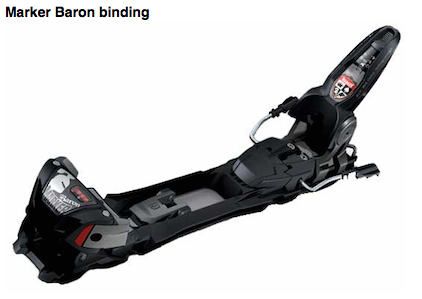
The Salomon Guardian is a variation on the Marker bindings but they have re-designed the walk ski mode. Again they are pretty heavy but popular with people who want a 'do it all' binding. It now comes in two din settings 13 and 16 for rugby players. Atomic also have the Tracker, which is the same as the Guardian as is the Fisher Adrenalin.
All these bindings do a good job of compromising between a downhill and pin binding. They are heavy but if you’re just doing the odd day tour then this might be the style to go for. Personally, I think the Salomon style and Marker Duke and Barron are way too heavy for serious ski tourers. The Diamir Eagle, Scout and the Marker F10 and 12 aren't a bad compromise if you still want the flexibility of a downhill-orientated binding.
Pin Bindings
So moving onto my favourite subject, pin bindings! Contrary to popular belief these have been around since the early 90's. I still have an old pair of early 90's fluro coloured Dynafits in my shed. Over the past few years a number of companies have taken on the challenge of trying to re-invent the wheel i.e. improve on the Dynafit design. Some have got it right, others have missed the point entirely! The essence of a good pin binding is it low weight high strength and simplicity.
Dynafit re-vamped their TLT range last year and its still really popular with tourers. After a few teething problems the range seems to have settled down and is now a good solid tried and tested platform perfect for any keen backcountry ski tourer. This year they have Given the Dynafit Beast a revamp with a lower din version of 14. With this binding Dynafit are trying to capture the freeride market as it has a sculptured inserts on the toe and heel to allow greater stability of the boot/binding interface. It works very well but does add quite a bit of weight: over 250gm more than a standard ST binding, so unless your going to rip the slopes hard it’s not really necessary. At the other end of the spectrum they have some of the best minimal race bindings on the market. If you want a practical yet weight conscious binding go for the TLT Speed Superlite at 185gm - with full release it’s a winner.
Plum are a French brand based a stone’s throw from Chamonix. Over the last few years they have made an excellent job of ‘re-inventing the wheel’ and keeping that all important ethos of light, strong and simple. Their bindings have a lot of high quality machined aluminum in them and look the business and work really well. They only have two touring orientated bindings in their range, but maybe that’s a good thing. The Plum Guide is a standard binding and the Plum Yak is for wider skis.
Diamir entered the market last year with the Vipec. After some initial teething problems they seemed to have settled down and currently are the only tried and tested pin binding on the market that has a traditional heel and toe release. I have tested these bindings and they worked well although I found getting my boot to engage into the heal piece rather awkward. There is a lot of plastic on them so only time will tell concerning their durability. You can also buy interchangeable coloured plastic pieces for them to match you outfit on the day! Woohoo!
Diamir Vipec binding
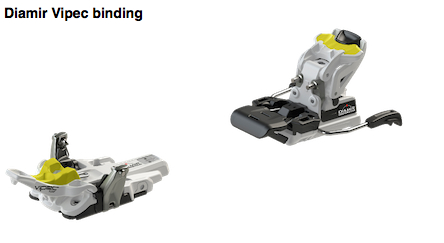
After three years of hush-hush development, Marker have now entered the pin binding market with the Kingpin. I can only describe this as a hybrid binding; the front looks like any other pin-tech binding with a few extra springs. However the heel concept is a drastic departure and uses a more traditional non-pin type mounting. They have added a few extra release plates to allow rubber sole compatibility also if you have low heeled touring boots you might need a bolt on boot adaptor to make the boot fit. This is more of a Freeride offering like the Dynafit Beast as its pretty heavy, but some people might like the ease of use and high build quality if they are only planning on the odd day tour. I suspect this is the pre-curser to a lighter version to give Plum, Dynafit and Diamir a run for there money.
Marker Kingpin binding

Finally Ski Trab have got their act together and finished the TR2 ready for this winter. While TR2 appears to be a “tech” binding, make no mistake: this is not a tech compatible boot or binding. Though the boot fittings appear to be somewhat “tech” (especially the toe) they are specific to TR2. In other words, you can’t snap a regular tech binding compatible boot into a TR2 and ski downhill — you have to use a boot with TR2 fittings. Note: thankfully you can snap a tech boot TOE into the binding and it’ll work in touring mode — in my view an essential safety factor if we end up having mixed groups of skiers using both tech and TR2 systems.
Ski Trab TR2 binding
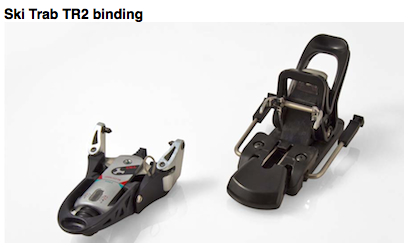
The TR2 weighs in at just 580gm and has some revolutionary new features. The lateral release at the toe with a DIN 11 allows skiers to lock the heel of the boot to the ski as with alpine race skis, allowing excellent sensitivity and perfect control of the ski. The wide binding plate at the tip reduces distance between the boot and the snow meaning more controlled motion while skiing. This was design in conjunction with Scarpa, who offer two boots especially for the TR2: Spirit TR2 and Spirit TR2 RS. I think its worth a look if your going down the new boot and binding road, but it might be hard to get hold of in the UK.
Personally I err on the side of 'light is right' and match a big ski like the Black Crow Navis with a Dynafit or Plum binding system.
Just thank your lucky stars you're not touring on these Ramer bindings from 1986…!!!
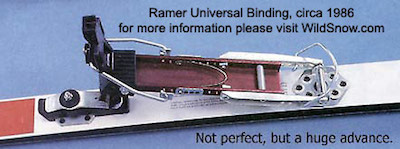
So moving onto my favourite subject, pin bindings! Contrary to popular belief these have been around since the early 90's. I still have an old pair of early 90's fluro coloured Dynafits in my shed. Over the past few years a number of companies have taken on the challenge of trying to re-invent the wheel i.e. improve on the Dynafit design. Some have got it right, others have missed the point entirely! The essence of a good pin binding is it low weight high strength and simplicity.
Dynafit re-vamped their TLT range last year and its still really popular with tourers. After a few teething problems the range seems to have settled down and is now a good solid tried and tested platform perfect for any keen backcountry ski tourer. This year they have Given the Dynafit Beast a revamp with a lower din version of 14. With this binding Dynafit are trying to capture the freeride market as it has a sculptured inserts on the toe and heel to allow greater stability of the boot/binding interface. It works very well but does add quite a bit of weight: over 250gm more than a standard ST binding, so unless your going to rip the slopes hard it’s not really necessary. At the other end of the spectrum they have some of the best minimal race bindings on the market. If you want a practical yet weight conscious binding go for the TLT Speed Superlite at 185gm - with full release it’s a winner.
Plum are a French brand based a stone’s throw from Chamonix. Over the last few years they have made an excellent job of ‘re-inventing the wheel’ and keeping that all important ethos of light, strong and simple. Their bindings have a lot of high quality machined aluminum in them and look the business and work really well. They only have two touring orientated bindings in their range, but maybe that’s a good thing. The Plum Guide is a standard binding and the Plum Yak is for wider skis.
Diamir entered the market last year with the Vipec. After some initial teething problems they seemed to have settled down and currently are the only tried and tested pin binding on the market that has a traditional heel and toe release. I have tested these bindings and they worked well although I found getting my boot to engage into the heal piece rather awkward. There is a lot of plastic on them so only time will tell concerning their durability. You can also buy interchangeable coloured plastic pieces for them to match you outfit on the day! Woohoo!
 Off-Piste
Off-Piste Ski Touring
Ski Touring Via Ferrata
Via Ferrata Ice Climbing
Ice Climbing Alpine Glacier Trekking
Alpine Glacier Trekking Worldwide Trekking
Worldwide Trekking



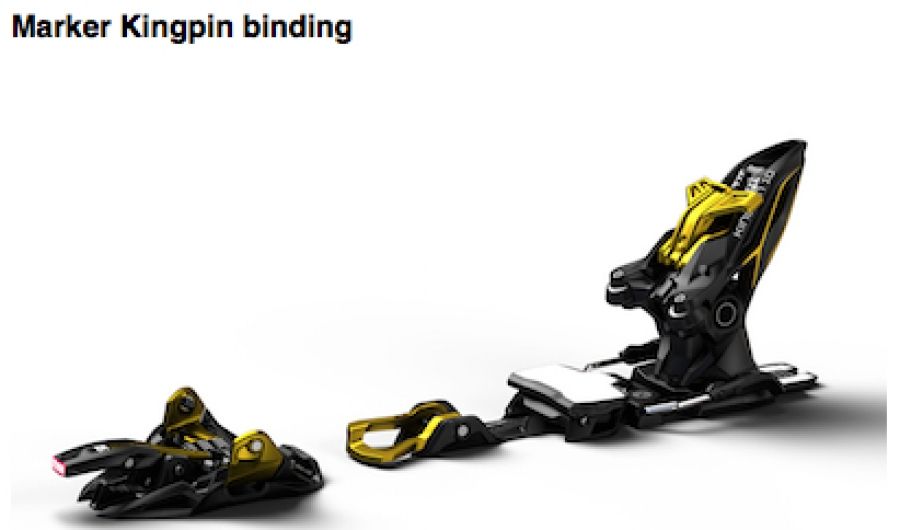





 Travel Website Development
Travel Website Development